5 January 2016
By Richard Bosselman
For: Quality cabin, impressive drivetrain, sets refinement standard.
Against: No cloth seat fabric option with Limited, some awkward in-cabin ergonomics, tray still not pallet-friendly and plastic liner costs extra.
Score: 4.2/5
SO here’s our first test of the Toyota utility whose reputation is forged on an ability to set the standard for rock-hopping, trail-blazing ‘go anywhere at any time and in any weather ability’ – and we’re driving the new model that self-limits such potential.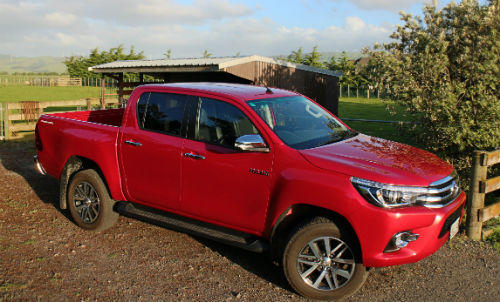
What sort of cop out is that, you might ask? Well, keep your bush shirt on, fellas – rest assured, Motoring Network doesn’t intend to ignore the all terrain-tuned models, whose forebears have been tackling this country’s toughest terrain for more than three decades.
At the same token, we’re also no more blind to the changing landscape of one tonne ute-dom than Toyota itself.
The market leader – in overall sales, not utes – itself acknowledges that the 10 years between Hilux servings has been a period of great change. High-end double cab diesel auto utes are increasingly being bought by families as substitutes for sports utility and station wagons.
Not only that, there’s been obvious demand for a sub-type of that breed that Toyota has, until now, been unable to provide: A top-of-the-tree model will the stance, specificiation and styling of the sharpest-dressed four-wheel-drive editions, yet lacking that elemental all-wheel-drive fixture.
Like we say, Toyota New Zealand (and Japan) missed the boat on that trend in the previous evolution of this truck and paid the heaviest price possible: Abdicating sector dominance, in 2014 and again last year, to Ford. A bitter blow given that, until then, Hilux – with 32 successive years on top – was heading to achieve a world-best sales run for any ute.
But it wasn’t to be. And all because the Blue Oval had a HiRider Ranger exactly build to a recipe that so many consumers have found tasty. TNZ will never tire of telling that Hilux, even when it was in its last year of sale and comfortably sited as the oldest design in this category, kept outselling Ranger in four-wheel-drive. It only lost ground in the territory where it wasn’t represented.
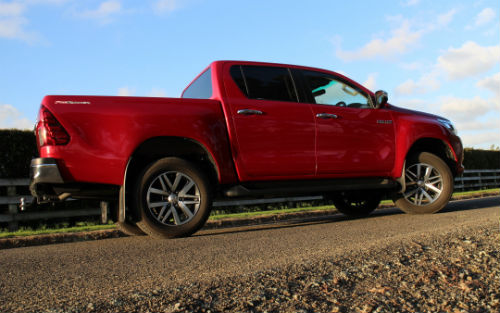 Now the gaps have been filled, and then some: With 21 Hilux derivatives, the generation Hilux is served in more flavours than ever. TNZ makes some obvious assumptions: More than nine out of 10 will supply in turbodiesel, around 70 percent of volume might sway to four-wheel-drive and the SR5 and new flagship SR5 Limited will account for at least 40 percent of preference.
Now the gaps have been filled, and then some: With 21 Hilux derivatives, the generation Hilux is served in more flavours than ever. TNZ makes some obvious assumptions: More than nine out of 10 will supply in turbodiesel, around 70 percent of volume might sway to four-wheel-drive and the SR5 and new flagship SR5 Limited will account for at least 40 percent of preference.
However, it also reckons this new PreRunner on test is going to snare a lot of sales. That’s why it is here in no less than five forms over three specification levels, topping with the $54,990 SR5 Limited tested here.
The one hanging question: With Toyota banging on about how this latest Hilux’s development was about imbuing it not only with lots more luxury but also a big dollop of extra toughness, does the flashest PreRunner deserve to be considered anything more than a townie truck, regardless that most buyers will very likely be those attuned more to Rodd and Gunn than genuinely rod and rifle?
Styling, image:
Intrinsically, one-tonne trucks are tailored for toil, yet let’s not delude ourselves: Gone are the days when a maker can expect an upmarket, urbane crowd to show much interest in a vehicle that is dressed for either the farm or the frontline.
The rise of the weekend warrior class makes it tough: On the one hand, it’s still all about durability but, on the other, those who buy utes – dual cabs especially – as style statements have high and even conflicting expectations. Basically, the market seems most keen on some that is car-like in respect to safety, refinement, kit content and comfort but not so much in respect to the kerbside attitude.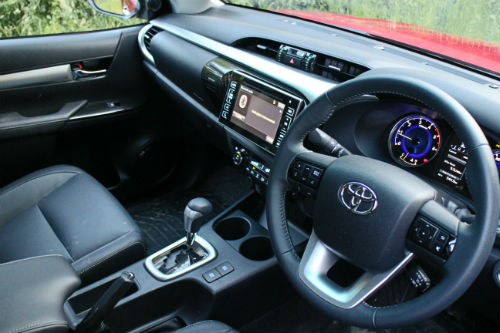
Affecting extra bright work, some additional in-cabin kit and fineries and perhaps a set of fancy stickers - all of which the PreRunner has – is well and good, but makings trucks look like cars is trickier. If we really wanted that, then surely the Mazda BT-50 would have been the one now holding No.1 status, not its much blockier under-skin twin, the Ford Ranger?
Well, anyway, it’s something Toyota gave a lot of consideration to when shaping the Hilux. While a remit to make this model more durable than the last ensured the engineers had the priority pathway for everything you don’t see, the stylists also had final say in how everything packaged, to ensure it would have the requisite street smarts.
One abiding requirement was to implement the latest Toyota family look into the rig’s front and rear, but only so far: With Hilux it has been more about achieving a general air of familiarity than creating a faithful reproduction, as Mazda did, and that’s made a huge difference.
The Hilux looks really smart, but it also still looks staunch. The double cab body shape is symmetrically pleasing in silhouette and has a real strength to it; Toyota’s intention to introduce a closer styling similarity with its North America-only Tacoma plays out; we don’t get the big flared wheelarches so beloved Stateside but its has a cowboy brawniness about it.
If you’re going to hear criticism, it’s going to be about the front end – seen square on, it looks good, but in profile the jutting nose is a bit on the long side and, because of the way the bottom part of the front angles up, it appears a touch weak-jawed.
If you want ‘car’, though, there’s more evidence within the new cabin. It’s certainly a step up on the old model in terms of presentation and materials. The feature that grabs immediate attention, a 7.0-inch floating touchscreen, is lifted from the Corolla. And the backlit gauges use the same technology as those favoured by Lexus. So, too, the use of a starter button to fire up the engine – no more turning a key in the Limited, at least. The chunky steering wheel has something many utes still don’t offer, reach and rake adjustment, which is a welcome addition for us taller drivers, so too the electric adjustment on the command seat, though the lowest setting is only just low enough for me. The SR5 Limited also dresses up with leather, the usual Toyota stuff that’s probably going to last the distance but is slippery and bit too shiny for me.
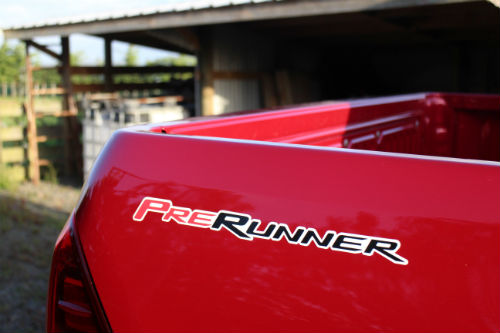 Obviously, as a working truck, it has lots of hard-wearing materials that are tolerant of a work boot or tool belt (the provision of panic-handles on the A-pillar and overhead for both front occupants is another nice reminder of its genetic basis), but even though some of the plastics are very hard, the surfaces are smart enough to meet family fulfilment.
Obviously, as a working truck, it has lots of hard-wearing materials that are tolerant of a work boot or tool belt (the provision of panic-handles on the A-pillar and overhead for both front occupants is another nice reminder of its genetic basis), but even though some of the plastics are very hard, the surfaces are smart enough to meet family fulfilment.
The front seating position is a pleasant hybrid of upright commercial utilitarian and SUV comfort but the back bench is where all the good work has been done. Never previously a great spot, the rear seat has improved now from the back rest being at a better angle and also thicker-cushioned. It’s no limo, but has become a feasible proposition for longer drives and there’s room for three adults. Also getting a nod is the fitment of Isofix anchors and top-tethers for the two outer seats.
The SR5s have LED lights, extra chrome, keyless start, sat-nav, a handy 220-volt power outlet for charging your laptop plus a cooled glove box. The Limited has all this plus leather, those eight-way power front seats, climate control in place of more orthodox air con, more chrome, and 18-inch alloys.
Beyond the back of the cabin is a tub that is now longer (by 19mm, now 1569mm) wider (up 79mm, now 1645mm) and slightly deeper than it was (up 20mm, now 481mm), though it isn’t as deep as some. The 1109mm wheel-arch gap still isn’t going to be able to fit a pallet.
Underneath is an all-new frame and platform that has been strengthened for better structural rigidity, and that new frame has meant that the benchmark 3.5-tonne towing capability that rivals have crowed about is now achieved by some variants.
Powertrain, performance:
The new 2.8-litre four-cylinder turbo diesel unit has a smaller capacity that the previous model and one fewer cylinder than its chief rival but shouldn’t be dismissed for those factors, not for producing less power and torque than some main rivals.
Being impressed last year with how well a mill making 130kW and 450Nm in six-speed automatic form (and 130kW/420Nm in manual) performed in LandCruiser Prado and figuring then that it would have to perform even more brilliantly in the substantially lighter Hilux was a safe call that proved right on the money.
While the new engine’s peak pulling power arrives higher in the rev range and doesn’t sustain as broadly as it did with the 3.0-litre, there’s substantially more torque so it never lacks for muscularity and rarely feels put out.
The typical clatter associated with diesel powered utes is almost entirely absent now; until it’s revved, you could be forgiven for imagining it’s not even a compression ignition unit. Those big revvy moments are relatively few because low-down torque is particularly abundant; for the most part it’s giving great service while putting less than 2000rpm on the clock.
In fact, the standout feature is the refinement. It is smoother in building momentum and impressively quieter than previous engine and that, in turn, makes for the vehicle as a whole to deliver marked improvement in noise, vibration and harshness.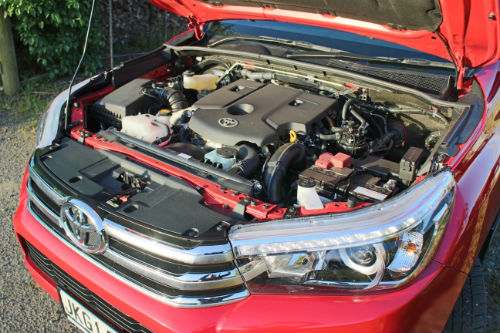
I’m a big fan of this six-speed automatic. It shifts gears smoothly and effectively, cleverly and cleanly dropping down gears when you brake, and even blipping the throttle in some situations.
Driving appeal:
Leaving the four-wheel-drive hardware at the factory is a give-and-take determination, but it does leave the PreRunner with significant advantages for on-road behaviour.
A kerb weight that diminishes by around 70kg almost certainly allows a performance edge, but beyond that the PreRunner potentially has the sweetest steering and the most compliant ride among all the tall-standing Hilux offers.
But don’t allow yourself to be lulled into thinking that it’s something other than a truck. No utility with a ladder frame, leaf spring rear suspension and load hauling as its primary reason for existence is going to deliver a car-like experience. Not just in respect to the dynamic element but also in driving feel; spending time tooling around town is a great reminder that, for all its luxuries, this Hilux is still a lot less urban-friendly than any car.
Actually, it’s less open road-friendly too though, when considerations are restricted to just its own kind, it’s good enough going to present as a better kind of truck.
As always, the most telling factor about its background and intent is that the rear suspension is still leaf-sprung. The leafs are 100mm longer, 50mm wider apart and have a front attachment point 100mm further forward for more suppressed road vibrations and reduced body roll, especially when loaded, and while you don’t get the same kind of compliance that comes with coils, the tuning isn’t too bad at all. In some respects, the rougher the surface condition, the better it seems: Driven unladen on a corrugated gravel road I use often, the test was surprisingly serene, producing relatively few suspension thumps. Since the road has not improved in all the time I’ve known it, the conclusion is surely that the Hilux has.
At the front end, the set up is double wishbone with a fatter anti-roll bar, while damper rates all round have been revised. Again, the intent is to improve upon the road manners, particularly to improve stability at speed, and it seems that this has been achieved. The vehicle turns in with confidence and there’s a pleasing accuracy and assertiveness to the steering feel.
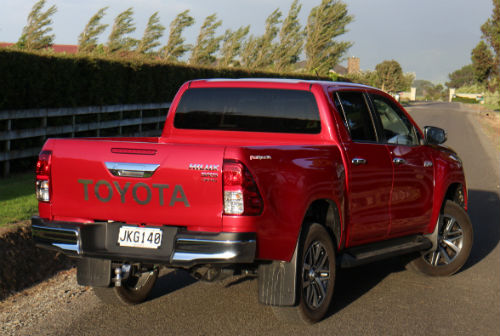 The overall height and towering 279mm ground clearance do influence cornering, but while body roll evinces earlier than in it would in a SUV, it will cope with some degree of heavy-handedness. The ESC, which has been tailored for loose surfaces, also does a good job of lending a helping hand without coming across as hamfisted and clattery. An unplanned full emergency stop was also a good opportunity to test some real-world braking performance: It did well.
The overall height and towering 279mm ground clearance do influence cornering, but while body roll evinces earlier than in it would in a SUV, it will cope with some degree of heavy-handedness. The ESC, which has been tailored for loose surfaces, also does a good job of lending a helping hand without coming across as hamfisted and clattery. An unplanned full emergency stop was also a good opportunity to test some real-world braking performance: It did well.
Taking the PreRunner off formed roads and onto modest terrain wasn’t a challenge – the stability and traction controls seem smart enough to help the truck manage obstacles and surface conditions in which wheel-on-ground traction is not always certain. We also towed, taking a small utility trailer loaded with two sheep and three burly lambs to a neighbour’s farm as stage one of a resettlement drive that put one of the young ‘uns into our freezer. It was a decent load, if well short of the 3200kg cited maximum.
A sharp climbing left hand corner at the foot of my mate’s gravel drive provided the moment when we’d wished for all-wheel-drive; I’d been too cautious on first try and lost traction – so ended up with the ute simply wheelspinning its Dunlop Grandtracks uselessly.
Not even the hill hold could help. A reverse back onto flat land and a better runup sorted the situation, but it did provide a reminder of what you are giving away. Having less pressure in the tyres (or some weight on the deck, which is rated for just under a tonne in this format) might have sorted this, also. On the other hand, the brief open road run between our properties reminded that the anti-sway electronics, that sense when large loads are wandering at speed and uses the ESC to regain control, is a good function.
How it compares:
No argument: Previous Hilux was in the market almost two years too long. It needed to get better – a lot better. Even so, the improvements that have arrived are really impressive; a reminder that, as Japan’s largest vehicle maker, Toyota isn’t one to do things by halves.
In saying that, within a fortnight of the Hilux being returned we were driving a Ford Ranger, in XLT four-wheel-drive doublecab format. That’s a very impressive truck whose mid-life improvements have made it even more compelling.
The PreRunner is a whole new game for Toyota and in the format we tried it is an admirable effort. There was plenty to like and it would certainly fit into our own semi-rural lifestyle.
It’s as rugged as the four-wheel-drive and, if you don’t expect to full explore the latter’s all-terrain ability, then the premium for four-wheel-drive over PreRunner - between $10,000 and $15,000 depending on model – simply shouldn’t be spent.
The notable quality of the new Hilux is its huge improvement in refinement. The combination of this, along with the family friendly comfort, makes the PreRunner a very valid foil to that Ranger HiRider that has been making all the difference for Ford.


